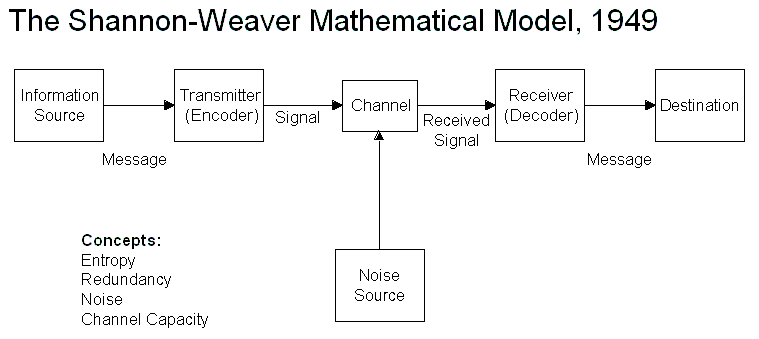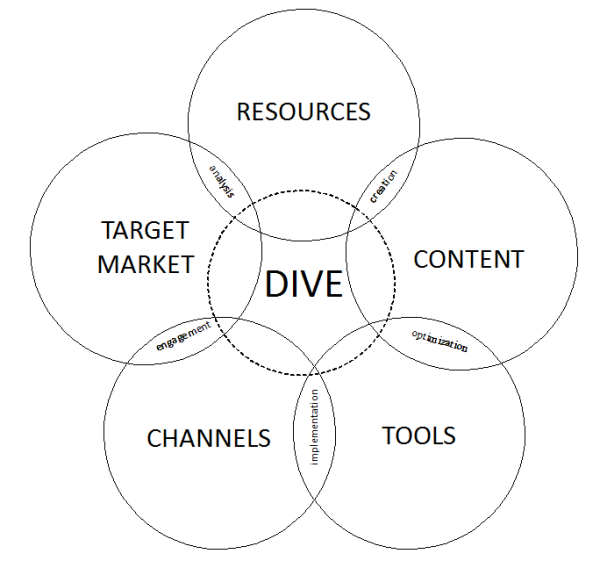I’m currently enthralled with the concept of creating a Communication Architecture that is both sturdy enough to stand up against any type of organizational setup and flexible enough to handle any type of messaging. These thoughts are simply ideas and concepts at this point. I have shared them with a few people live and received good feedback/tweaks, but never posted them online for greater scrutiny.
There have been many communication models throughout time. One of the most popular being The Shannon-Weaver Mathematical Model, 1949

But these type of models don’t give any process management ideas, workflow integration, or specialization opportunities. I’m trying to build something that others can then take the blueprint and build their own custom version on top of the Communication Architecture foundation.
5 core factors to consider in Communication Architecture
Target Market: a detailed profile of the intended recipient of a message. the more intimate knowledge of the target, the more engagement opportunities. this person or these people Decode, Interpret, and Encode Responses to your signals.
Resources: there are two types of resources: Internal and External. Internal includes things such as your brand identity, business facts, the knowledge in your head and that of others in your organization. External includes things such as industry white papers, blogs, thought leaders, and even competitors.
Content: content is created using the resources available to you. it is the creation of a story/message to share with others. examples include photos, videos, presentations, surveys, audio, links, notes, and written articles.
Tools: these are typically owned by the organization and used to optimize and implement content. modern tools include wordpress, mailchimp, vimeo, polldaddy, rss, and photoshop
Channels: this is the location in which you choose to publish/share your communication. Also known as a medium, it includes custom communities/forums, websites, email, facebook, twitter, linkedin, yelp, youtube, landing pages, and ads.
When assembled as a Venn diagram you begin to see how these factors work together.

Communication Architecture
The overlaps symbolize critical activities in the cycle of communication
Creation is the act of taking resources and turning them into content. Example: a property listing into an open house announcement.
Optimization is the act of enhancing the content by using a tool. Example: cropping the property photos and editing the text.
Implementation is the act of publishing from a tool into a channel. Example: mailing the postcard or posting to facebook.
Engagement is the act of a target market interacting within a channel. Example: some likes your facebook status or reads the postcard.
Analysis is the act of interpreting the results from the target market feedback and determining if they can be used as future resources. Example: click rate on the facebook message or response rate of the postcard.
Job Description from Communication Architecture
An individual or organization may have strengths in one area or another, but a complete understanding of the whole architecture will help improve communication both internally and externally. The overlapping acts could also be interpreted as jobs within an organization.
Creation = Author/Photographer
Optimization = Editor
Implementation = Publisher
Engagement = Community Manager
Analysis = Data Analyst
But what is DIVE?
You shouldn’t communicate at all if you don’t have at least one of the DIVE. The more, the better.
Data: plain facts.
Information: organized data given context.
Value: what is the information worth given cost to acquire.
Experience: the quality of enjoyment derived from receiving the value
When building a brand value and experience are critical to long-term success. Almost anyone can share data. Most can turn data into information. The smart find ways to deliver information with value. Those with raving fans create an amazing experience combined with the value.
– so there, I did it. I put my initial thoughts down for the world to critique. Have a go.
# special thanks to Mike Pennington for his thoughts and energy helping me get to this point. and a nod to Gahlord Dewald for pushing me to publish this online. I look forward to building more around this concept.

Brad,
I haven’t seen anything like this from other sources in real estate (or otherwise). I think it’s awesome!
This should become the basis of understanding for anyone who wants to message anything.
The ‘Brad Nix Communications Model of 2010’ 🙂
Thanks Matt. I’m certain this has some holes in it, but I think it’s worth the criticism to create a better foundation for modern communication processes within an organization.
We hear a lot about the Tools, Channels, and Content but not enough about the Resources and Target Market or how they should all work together.
I LOVE this Brad! Well done to get this formulated into a deliverable format and having the wherewithal to put it out for discussion.
I’m not entirely “feeling” all the parts of DIVE…and this may be purely semantic. For VALUE, “what is the information worth given cost to acquire” – who determines what the info is worth…metrics? For EXPERIENCE, “the quality of enjoyment derived from receiving the value” – again, where and by whom is this “quality” determined…sentiment?
The overlap in Resources and Target Market on the diagram…”analysis” could use some expansion…somewhere. I say this because you have brilliantly included job descriptions from within the diagram/architecture – this one point leaves me with questions that beg actionable answers.
I would love to see you carry through with this and perhaps add an infographic (Dina!). An expanded post put together after you have received some input and refined this architecture and discipline would be very valuable. Best of luck with this Brad, I hope that you get lots of input, traffic, and mileage from this. Well done indeed!
James-
Thanks for your comments. Let’s try work out your concerns here. If too lengthy, maybe over coffee at WCH next week.
Value would be dependent upon the target market and they ultimately ‘decide’. But if you do enough analysis, you should know what problems they have and deliver messages aimed at helping answer them. Thus providing value.
The Experience the target has while receiving the value is harder to control, but again the analysis phase should help point you in the right direction. Did they share the message with their sphere? Did they ‘like’ it for others to see? Experience may be enhanced by message format (video over photo as example), but is completely target centric.
or maybe I’m wrong? should the DIVE elements only be things the Encoder controls directly? If so, then it’s much closer to types of “knowledge” as Gahlord has started to consider over here: http://thoughtfaucet.com/strategy/orientation/knowledge-data-meaning-and-stuff/
As for the overlap in Resources and Target Market, I view this as where you analyze the market segments to determine the type of resources your organization should create in order to fulfill target market needs/wants. I guess the term ‘analysis’ here has a dual meaning, as it also means the metric observations of things such as clicks, likes, retweets, phone calls, etc… in addition to analyzing the market demographics and psychographics.
Keep pushing me and we may create something others can use.
Thanks for the clarification Brad…and thanks for the Gahlord link (nice article!) as well. Let’s do try to get together over coffee at WCH next week sometime, I’d love to hear more about this and discuss!
ok, lots of conversation offline stemmed form this post and I have an update to these thoughts formulating. revision post to follow soon. let’s just say that Resources and Content are closer to synonyms than the model was intended. New definitions and clarity to follow.
Ok Brad, here’s my input. I think you’re on a great idea here. The way I see it you have two paths to take with it. One would be using this to try to get your average agent or business person to understand it. In this path simplicity is the best policy. Your diagram has the potential to be very useful to them to give a visual to help them understand the overall communication concept.
The other path is to expand on what each of these parts represents in a real world application and how to apply the available technology to make it work. This path would be good for the tech and business savvy, but may leave many in the dark.
Signed, The omni-present Brodie Brown, king of my own domain and ruler of all things ending in ‘ie’.
Exactly Brodie. This is just a base model. Each of these lenses represent much deeper processes to be expanded upon and customized per organizational goals. Version 2 coming soon. Keep me pushing me to fine-tune for easy adoption.
These thoughts have evolved: http://bradnix.com/communication-architecture-evolved/